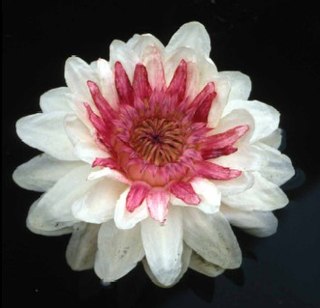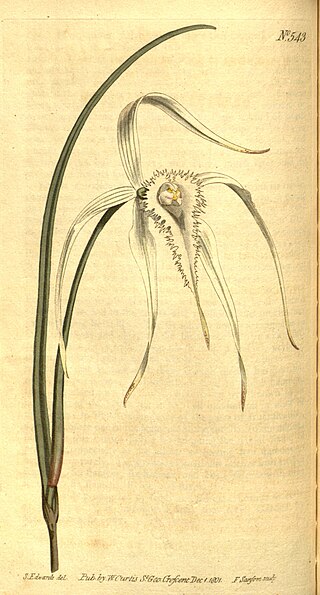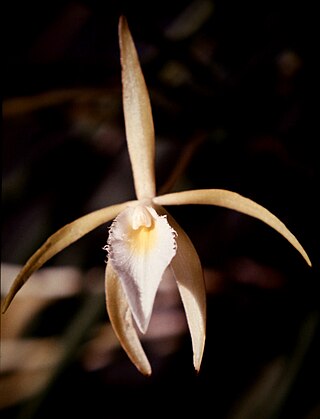
Brassavola is a genus of 21 orchids. They were named in 1813 by the Scottish botanist Robert Brown. The name comes from the Italian nobleman and physician Antonio Musa Brassavola. This genus is abbreviated B. in trade journals.

The 51st United States Congress, referred to by some critics as the Billion Dollar Congress, was a meeting of the legislative branch of the United States federal government, consisting of the United States Senate and the United States House of Representatives. It met in Washington, D.C., from March 4, 1889, to March 4, 1891, during the first two years of Benjamin Harrison's presidency.

The 53rd United States Congress was a meeting of the legislative branch of the United States federal government, consisting of the United States Senate and the United States House of Representatives. It met in Washington, D.C., from March 4, 1893, to March 4, 1895, during the first two years of Grover Cleveland's second presidency. The apportionment of seats in the House of Representatives was based on the 1890 United States census.

The 56th United States Congress was a meeting of the legislative branch of the United States federal government, composed of the United States Senate and the United States House of Representatives. It met in Washington, D.C. from March 4, 1899, to March 4, 1901, during the third and fourth years of William McKinley's presidency. The apportionment of seats in this House of Representatives was based on the 1890 United States census. Both chambers had a Republican majority. There was one African-American member, George Henry White of North Carolina, who served his second and final term as a representative in this Congress, and would be the last black member of Congress until 1928, and the last black member of Congress from the South until 1972.

The 57th United States Congress was a meeting of the legislative branch of the United States federal government, composed of the United States Senate and the United States House of Representatives. It met in Washington, DC from March 4, 1901, to March 4, 1903, during the final six months of William McKinley's presidency, and the first year and a half of the first administration of his successor, Theodore Roosevelt. The apportionment of seats in the House of Representatives was based on the 1890 United States census. Both chambers had a Republican majority.

The International Phonetic Alphabet was created soon after the International Phonetic Association was established in the late 19th century. It was intended as an international system of phonetic transcription for oral languages, originally for pedagogical purposes. The Association was established in Paris in 1886 by French and British language teachers led by Paul Passy. The prototype of the alphabet appeared in Phonetic Teachers' Association (1888b). The Association based their alphabet upon the Romic alphabet of Henry Sweet, which in turn was based on the Phonotypic Alphabet of Isaac Pitman and the Palæotype of Alexander John Ellis.

The 55th United States Congress was a meeting of the legislative branch of the United States federal government, composed of the United States Senate and the United States House of Representatives. It met in Washington, D.C., from March 4, 1897, to March 4, 1899, during the first two years of William McKinley's presidency. The apportionment of seats in the House of Representatives was based on the 1890 United States census. Both chambers had a Republican majority. There was one African-American member, George Henry White, a Republican from the state of North Carolina, and one Kaw member, Charles Curtis, a Republican from Kansas.
Sir Henry Stuart Jones, FBA was a British academic. He was educated at Balliol College, Oxford; he obtained a First in Classical Moderations in 1888 and a First in Literae Humaniores in 1890. He was appointed to a Fellowship at Trinity College, Oxford, in 1897.

The 44th United States Congress was a meeting of the legislative branch of the United States federal government, consisting of the United States Senate and the United States House of Representatives. It met in Washington, D.C. from March 4, 1875, to March 4, 1877, during the seventh and eighth years of Ulysses S. Grant's presidency. The apportionment of seats in the House of Representatives was based on the 1870 United States census. For the first time since the American Civil War, the House had a Democratic majority. The Senate maintained a Republican majority.
The Global Industry Classification Standard (GICS) is an industry taxonomy developed in 1999 by MSCI and Standard & Poor's (S&P) for use by the global financial community. The GICS structure consists of 11 sectors, 25 industry groups, 74 industries and 163 sub-industries into which S&P has categorized all major public companies. The system is similar to ICB, a classification structure maintained by FTSE Group.

The 46th United States Congress was a meeting of the legislative branch of the United States federal government, consisting of the United States Senate and the United States House of Representatives. It met in Washington, D.C. from March 4, 1879, to March 4, 1881, during the last two years of Rutherford Hayes's presidency.

Prosthechea is a genus of flowering plants in the orchid family (Orchidaceae). The name is derived from the Greek word prostheke (appendix), referring to the appendage on the back of the column. Appendage orchid is a common name for this genus. Prosthechea is abbreviated Psh. in the horticultural trade.

Laeliinae is a Neotropical subtribe including 40 orchid genera, such as Brassavola, Laelia and Cattleya. The genus Epidendrum is the largest within this subtribe, containing about 1500 species. This is followed by the genus Encyclia, with over 120 species.

The Flora of Colombia is characterized by over 32,000 species of green plants.

Brassavola cucullata, common name daddy long-legs orchid, is a species of orchid native to Mexico, Belize, Central America, the West Indies and northern South America.

Brassavola flagellaris is a species of epiphytic orchid of the Cattleya alliance. It grows wild in eastern Brazil, where it fills the evening air with the citrus-like fragrance of its blossoms.

Brassavola martiana is a species of orchid found in South Tropical America. It is reported from Brazil, Peru, Colombia, Venezuela, French Guiana, Guyana and Suriname.

Brassavola nodosa is a small, tough species of orchid native to Mexico, Central America, the West Indies, and northern South America. It is also known as "lady of the night" orchid due to its citrus and gardenia-like fragrance which begins in the early evening. It has been widely hybridized and cultivated for its showy flowers and pleasing scent.

Brassavola subulifolia is a species of orchid endemic to Jamaica.

The Gulf and Ship Island Railroad (G&SI) was constructed in the state of Mississippi, USA, at the turn of the 20th century to open a vast expanse of southern yellow pine forests for commercial harvest. In spite of economic uncertainty, entrepreneurs William H. Hardy and Joseph T. Jones successfully completed railroad construction. The railroad resulted in the development of a seaport and expansion of cities along its route.












